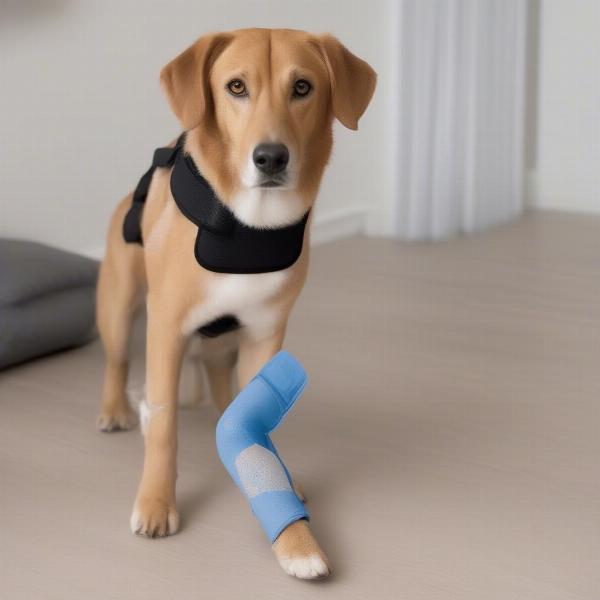Dog leg protectors are essential for many dogs, offering support, protection, and comfort. Whether your dog is recovering from an injury, suffering from arthritis, or simply needs extra support during strenuous activities, choosing the right leg protectors can significantly improve their quality of life. This guide will delve into everything you need to know about dog leg protectors, from choosing the right type to proper usage and care.
Types of Dog Leg Protectors and Their Uses
Several types of dog leg protectors cater to different needs:
-
Support and Stability Sleeves: These sleeves provide compression and support to injured or weak legs, aiding in recovery and reducing pain. They are often used for conditions like arthritis, sprains, and post-surgical recovery.
-
Protective Boots: Designed to shield paws and legs from harsh elements, these boots protect against extreme temperatures, rough terrain, allergens, and irritants. They are ideal for hiking, winter walks, or navigating urban environments.
-
Wound and Bandage Covers: These protectors keep wounds and bandages clean and dry, preventing infection and promoting healing. They are crucial for post-surgical care and managing injuries.
 Types of Dog Leg Protectors
Types of Dog Leg Protectors
Choosing the Right Dog Leg Protectors
Selecting the appropriate leg protectors involves considering your dog’s specific needs:
-
Size and Fit: Accurate measurements are crucial. Measure your dog’s leg circumference and length to ensure a snug but comfortable fit. Ill-fitting protectors can restrict movement or rub against the skin, causing discomfort.
-
Material: Choose breathable and durable materials like neoprene or mesh for support sleeves. For protective boots, look for waterproof and rugged materials. Wound covers should be made from non-irritating and easily cleaned materials.
-
Purpose: Consider the primary reason for using leg protectors. Is it for injury support, protection from the elements, or wound care? This will guide your choice towards the most suitable type.
-
Activity Level: If your dog is highly active, choose protectors that offer flexibility and durability. For less active dogs, comfort and support should be prioritized.
How to Use and Care for Dog Leg Protectors
Proper usage and maintenance are essential for maximizing the effectiveness of dog leg protectors:
-
Introduction: Introduce the protectors gradually to your dog to allow them to adjust. Start with short periods of wear and gradually increase the duration. Positive reinforcement and treats can help make the experience positive.
-
Secure Fit: Ensure the protectors are securely fastened but not too tight. Check regularly for any signs of rubbing or discomfort.
-
Cleaning: Follow the manufacturer’s instructions for cleaning. Most protectors can be hand-washed or machine-washed on a gentle cycle. Ensure they are completely dry before reapplying.
-
Inspection: Regularly inspect the protectors for any signs of wear and tear. Replace worn-out protectors promptly to ensure continued effectiveness.
When to Consult a Veterinarian
While dog leg protectors can be beneficial, it’s important to consult a veterinarian:
-
Underlying Conditions: If your dog is experiencing lameness or pain, consult a vet to diagnose any underlying conditions before using leg protectors.
-
Wounds or Injuries: For wounds or injuries, veterinary guidance is essential to ensure proper treatment and prevent complications.
Conclusion
Dog leg protectors offer valuable support, protection, and comfort for dogs in various situations. Choosing the right type and ensuring proper usage and care are crucial for maximizing their benefits. Remember to consult your veterinarian for any underlying health concerns or injuries. By providing appropriate leg protection, you can significantly improve your dog’s mobility, comfort, and overall well-being.
FAQ
- How long can a dog wear leg protectors? The duration depends on the dog’s needs and the type of protector. Consult your veterinarian for specific recommendations.
- Can dog leg protectors be used for all breeds? Yes, leg protectors are available in various sizes to fit different breeds.
- Are dog leg protectors expensive? The cost varies depending on the type, brand, and size.
- Can my dog sleep with leg protectors on? This depends on the type of protector and your vet’s recommendations.
- Do dog leg protectors restrict movement? Properly fitted protectors should not significantly restrict movement.
- Can I make my own dog leg protectors? While DIY options exist, commercially available protectors offer better fit and functionality.
- How do I know if my dog’s leg protector is too tight? Signs of a too-tight protector include redness, swelling, or your dog excessively licking or chewing at the area.
Related Articles
About ILM Dog
ILM Dog is your trusted international resource for comprehensive dog care information. We specialize in providing expert advice on dog breeds, health, training, nutrition, grooming, and much more. From choosing the right breed to ensuring optimal health and well-being, ILM Dog empowers dog owners worldwide with the knowledge they need. Contact us for expert advice and support: [email protected] | +44 20-3965-8624. Visit us at ILM Dog for a wealth of resources and information.